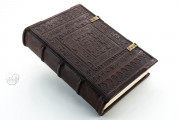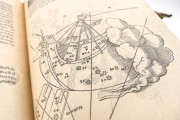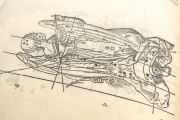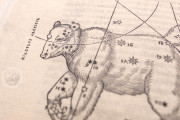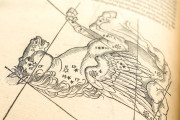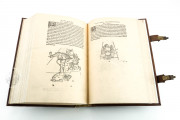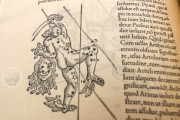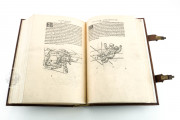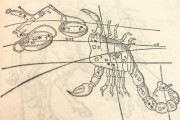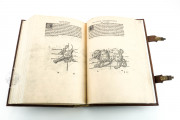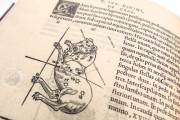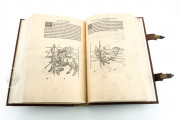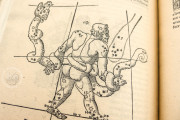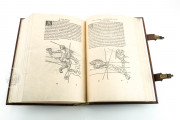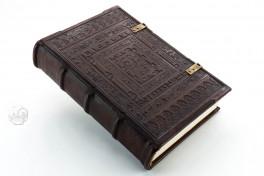The first edition, modeled after one of the eleven original copies found in Poland. From the Königsberg collection of Duke Albert of Prussia.
The Greatest Work of Copernico
Copernicus' heritage has acquired quite an ample bibliography. Among it, works dedicated to the greatest work of his life, De revolutionibus orbium coelestium libri VI, have a prominent place. Though there are fairly few studies discussing them in the bibliopolical aspect, i.e. registering the individual features of the surviving copies of the 16th century editions of this work with bookplates in the first position.
In 1970 Owen Gingerich decided to fill this gap, which was particularly palpable in studies over the history of the reception of the heliocentric theory. He undertook an extremely painstaking and time-consuming search for the surviving copies of the 1st and 2nd edition of De revolutionibus from 1543 (Nürnberg, Joh.Petreius) and 1566 (Basel, Henricpetri).
The search, conducted in famous and lesser libraries, not without incident so compellingly recounted by professor Gingerich, gave very interesting results. Gingerich registered over 250 copies of the first edition. This is at least half of the print-run estimated for 400-500 copies.
This number includes the twelve copies found in Poland or one copy less, if the print from the Library of the Polish Academy of Sciences stolen in November 1998 was smuggled out of Poland. The most interesting copy in terms of provenance and artistic features is the one held in the collection of the Library of the University of Torun – reference number Pol.6 III.142.
The Nova Library
It was brought to Torun already after World War II, at the end of the 1940s together with a batch of books from the so-called Nova Library, also known as the Castle Library, the oldest foundation of the State and University Library in Königsberg. The origins of this library, which was so named to juxtapose it against the old library of Duke Albert called the Deutsche Liberei or Kammerbibliothek, can be traced to the purchase of 68 books in 1529 by Crotus Rubeanus, the secretary of the Prussian ruler, know better as the co-author of Epistolae obscurorum virorum.
As intended by its founder, this library was to serve as a scientific library for the scientific community of Königsberg, and after the founding of the University in Königsberg in 1544 also as an academic library. These plans were realized consistently. After collecting around one thousand tomes in 1540, the library was opened to the public. It is worth mentioning that the opening ceremony was honored with a poetry reading by the professor of the gymnasium from Elblag, Wilhelm Gnapheus – the author of rather poor plays, including Morosophus, where he supposedly ridiculed the Copernican theory, outlined by Georg Joachim Rheticus in Narratio Prima (Gdansk, F. Rhode 1540).
The Journey of the Book
The manuscript then changed hands on several occasions to be nationalized in 1945 in Prague, along with the entire library of the Silesian Count, Otto von Nostitz. On 5 July 1956 this priceless artifact was officially handed over (although physically it was already in Poland since 1953) by the Czechoslovakian government to the Polish nation to ultimately rest in the collection of the Jagiellonian Library.
De revolutionibus (just as the two remaining works) was probably purchased or gifted to the Königsberg court. This was the provenance of the vast majority of books from the Castle Library. Books were imported from nearly all countries of Western Europe. The analysis of the contents of the surviving tomes from the ancient catalogue, numbering just over 700 prints, with respect to typographic provenance, indicates that most of them originated from Basel, the largest printing center of Europe at the beginning of the 16th century, while Nuremberg, where Copernicus' work was printed was fourth in this respect, after Strasbourg and Wittenberg, while Cologne, where the Hyginus' and Ptolemy's works were printed, was fifth. We cannot exclude the De revolutionibus, just as the prints of Hyginus and Ptolemy, were delivered to the Konigsberg castle by professional bibliopoles.
The Prussian Duke
Equally probable is the speculation that the copy of the first edition of De revolutionibus kept in the collection of the University Library in Torun is the same print received by the Prussian Duke in 1543 from a canon from Warmia, Georg Donner, belonging to the small circle of the closest friends of the great loner from Frombark, convinced of the validity of the heliocentric theory.
The Duke, having extensive contacts with theologians, scientists, publishers etc. did not place all the books, numbering around a thousand tomes at the end of his live, gifted by them in his private collection. He donated many of them, primarily duplicates, to the Castle Library.
We may assume that e.g. the print containing G.J. Rheticus' Narratio Prima (Gdansk, F. Rhode 1540) registered in Polyphemus' catalog relates to one of two copies of this work received from the Bishop of Pomesania, a distinguished bibliophile, Pawel Speratus, and the Bishop of Warmia, Tiedmann Giese. In the library he also deposited books that failed to grasp his interest. Supposedly, this is why he donated the copy of De revolutionibus gifted by Donner.
The End of the Journey
We can say with near certainty that it arrived from Nuremberg from the capital of Ducal Prussia as a purchase or gift from Donner. Next, regardless of its path to the residence of the Prussian ruler, still in 1543 it was merged by the ducal librarian, together with the prints of Hyginus and Ptolemy into one block, and after being bound by Caspar Angler and registered in volume IX of the typographic catalogue it was incorporated to the Castle Library.
It remained in that collection until 1944. At the end of World War II, the retreating German army took over the collection of the Königsberg library and took it west. The changing fates on the wartime fronts forced the Germans to abandon the entire transport in the Karwiny manor, near Paslek, i.e. within the new borders of Poland. This way, during post-war turmoil it was transported to the newly founded university library. The Königsberg copy of "De revolutionibus…" is one of its most valuable volumes.
Binding description
The volume was equipped with 29 x 16 cm boards, covered with brown calfskin, the same one used to bind books from the Castle Library during Polyphemus’ tenure as librarian. Later it was replaced by white pigskin popular in Germany at the time. The covers are connected with the book block using 3 bounds. The spine is covered with dark brown leather, applied probably in the 19th century in place of the original leather, now visibly worn due to frequent use.
We have 2 facsimiles of the manuscript "Nicolaus Copernicus - De revolutionibus orbium coelestium libri VI":
- Mikołaj Kopernik - De revolutionibus orbium coelestium libri VI facsimile edition published by Bernardinum Wydawnictwo, 2006
- Mikołaj Kopernik - De revolutionibus orbium coelestium libri VI facsimile edition published by Orbis Pictus, 2006


